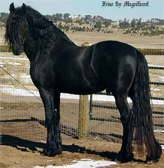Farrier Schedule/Foot Trimming
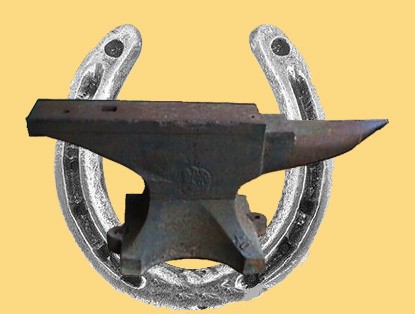 Your farrier is often the first line of defense against Insulin Resistance Laminitis. They see the hoof regularly and will pick up changes or notice a lameness on visits. They are a major part of the team and will be consulted regularly on blood tests and radiographs. Your Farrier has important experience with the hoof which is vital in knowing what has or has not worked in the past.
Your farrier is often the first line of defense against Insulin Resistance Laminitis. They see the hoof regularly and will pick up changes or notice a lameness on visits. They are a major part of the team and will be consulted regularly on blood tests and radiographs. Your Farrier has important experience with the hoof which is vital in knowing what has or has not worked in the past.

They will notice signs of possible Insulin Resistance such as:
- Overly sensitive response as they put nails in – the horse flinches more than in the past.
- Laminitis with no known cause.
- Sore-footed more in the Winter.
They will help protect the feet in several ways:
- Trim on a regular and more frequent (4 weeks ideal) basis.
- They may put shoes on a usually barefoot horse or add thin sole pads/protectants because of increased sensitivity of the foot. The horse is not Laminitic but moves short. Seen in people with neuropathic foot pain – the phenomenon of “allodynia”: pain-related behavior in response to normally innocuous stimuli. For example, going sore on frozen/hard ground in the Winter that usually is no problem to other horses at the barn.
- The use of glue-on shoes in the face of a Laminitis attack. Nails should be avoided in the acute phase, but glue-on shoes can go on quickly to lift up and protect the sole. Often needs only one or two sets of glue-ons and then can go back to usual routine.
- Your Farrier may request radiographs in order to know how much toe to remove or to improve balance or see improvement with glue-ons/bar shoes.
If your horse is sore after routine trims, you do not need a new farrier, you need to get the horse tested.
Radiographs also give your Farrier the proper toe length to maintain your horse in future trimmings. This information gives them the “safe zone” — how much can I trim without being close to the coffin bone and what is a good guideline so I can measure out a consistent toe length each visit.
For example, a certain small pony named Brandy, with past Laminitis episodes, is moving well now and radiographs show an ideal toe length of 2 3/4 inches from coronet to toe on the dorsal aspect. This number allows the owner to help the team monitor the length and give the Farrier information. If the schedule is every six weeks but the toe length is 4 inches at five weeks, the owner can set up more frequent Farrier visits. This number avoids feet being sore from being too long or sore from a dramatic trimming needed to “catch up”.
***Remember, x-rays will not show hoof quality and dynamics — the ideal toe length is only a safety guide. Your farrier may see things requiring less trimming that visit. The foot talks to the Farrier. They trim a foot not a radiograph.
Best Glue-On Shoe:
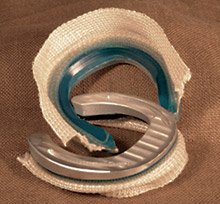 We have seen this shoe turn very painful horses around in 10 minutes or 1-2 days. The shoe puts NO GLUE on the bottom of the foot, so there is no instability in putting the foot down after applying. (Smearing/shifting as weight is put on it.) This shoe once applied sets up in less than 1 minute, so you are not wrestling to keep it up if the opposite foot is sore.
We have seen this shoe turn very painful horses around in 10 minutes or 1-2 days. The shoe puts NO GLUE on the bottom of the foot, so there is no instability in putting the foot down after applying. (Smearing/shifting as weight is put on it.) This shoe once applied sets up in less than 1 minute, so you are not wrestling to keep it up if the opposite foot is sore.
How to get it:![]() www.soundhorse.com or 1-800-801-2654. Company: Sound Horse Technology. Get the size of the foot to order from your Farrier. Order the Series I Fabric Cuffed Morrison Roller Action Shoe. The entire kit is only $70.00, for front feet shoes.
www.soundhorse.com or 1-800-801-2654. Company: Sound Horse Technology. Get the size of the foot to order from your Farrier. Order the Series I Fabric Cuffed Morrison Roller Action Shoe. The entire kit is only $70.00, for front feet shoes.
A fabric cuff goes over the outside of the hoof wall. A shock absorbing urethane pad is bonded to the shoe for further help. The shoe slips on like a slipper and quickly and strongly bonds. Most universities use this shoe now in Laminitis. Most Farriers, when they use it once, will use no other glue-on shoe.
A. Scenario: Client with a horse on HEIRO™ that has been doing great all of a sudden is foot tender. Why?
These horses taught us a big lesson – most were overdue for a hoof trim. Insulin Resistant horses need a rigid 4-6 week trim schedule – never go over 6 weeks. Get with your Farrier on a schedule such as “every 2nd Tuesday of the month”. Even one week overdue can be a problem. Also, clients tell us the horse on HEIRO grows foot faster than other horses at the farm. Good quality, strong feet help keep your horse sound.
B. Scenario – What can I do as an owner to help my Farrier?
1. Paint the bottom of the sole 2-3 times a week with Venice of Turpentine to toughen it up and decrease bruising – also it is an antiseptic so any little wounds are tended. Simple and easy. Really helps.
2. If your horse is a thin soled/stingy footed type, feed six (6) Zinc tablets (50 mg per tab) once a day, every day. Your horse will eat them up “as is” when fed in the morning. Get Zinc tablets at any grocery store or in the pharmacy in the vitamin section. It costs very little.
3. If your horse has shelly, poor quality feet – Isoxsuprine Tablets cause a burst in hoof growth. We have found them of little help in navicular disease but even a low dose, once a day, will help grow the foot. One bottle will last about 2 months if fed 15-20 once a day. Again, inexpensive.
![]()
 4. Often, you can avoid a problem after a Laminitis event, by bracketing the 2nd and 3rd trims with low dose Equioxx Tablets. This is a Cox2 blocker known to help quiet the Neuritis seen in these horses (nerve pain). On the morning of the trim, 1 tablet and on the night of the trim, another tablet. The next morning, give 1 tablet of Equioxx and stop. You avoid a problem instead of having to react to one. The trim is then comfortable and the horse can move.
4. Often, you can avoid a problem after a Laminitis event, by bracketing the 2nd and 3rd trims with low dose Equioxx Tablets. This is a Cox2 blocker known to help quiet the Neuritis seen in these horses (nerve pain). On the morning of the trim, 1 tablet and on the night of the trim, another tablet. The next morning, give 1 tablet of Equioxx and stop. You avoid a problem instead of having to react to one. The trim is then comfortable and the horse can move. ![]() Click here to see Neuritis – What’s That?
Click here to see Neuritis – What’s That?
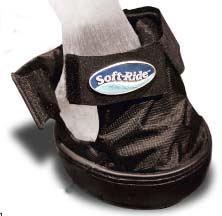 5. Foot Protection – For clients wanting to avoid shoes or needing a bridge before putting on shoes:
5. Foot Protection – For clients wanting to avoid shoes or needing a bridge before putting on shoes:
- Many clients have seen improvement in alleviating foot pain using the Soft-Ride Boots. You can size them on the site. Order the Turquoise (blue) colored standard insert.
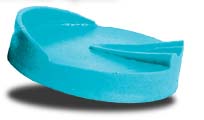 You need to take them off for 30 minutes a day to let the foot dry out or as the horse improves, use them when outside and take them off when in the stall. You can call phone number 855-763-8743 or go on line to
You need to take them off for 30 minutes a day to let the foot dry out or as the horse improves, use them when outside and take them off when in the stall. You can call phone number 855-763-8743 or go on line to  www.softrideboots.com.
www.softrideboots.com. - Clients will also use them in early Laminitis and when the horse’s foot improves, go on to use glue-on or other types of Laminitis shoes.
No matter how talented the farrier or impressive a job they do putting on a variety of Laminitis shoes – it will not work if underlying Insulin damage continues. The house is on fire and putting on an addition won’t help. Give the farrier the ability to succeed by testing and controlling Insulin.
6. Biotin (Vitamin H)
A. Several studies have shown it is of benefit and is a great product to add to your horse’s diet.
- Recent study by the University of Tennessee, College of Veterinary Medicine showed it is of benefit.
- A Cornell study (Eq. Practice, 1987) and a separate university study (Vet Record 1984) showed feeding 15 mg of Biotin a day after a five-month period showed “marked improvement” to hoof quality and improved all 55 horses in the study.
- A study of Lipizzaner Stallions after six months on Biotin showed increased white line condition and hoof tensile strength. (Proc. Eq. Nutrition, 1993).
B. Here are two sources of Biotin that are easy to administer and horses will enjoy. Biotin is not stored in the body, so a daily supplement is a good idea.
-
Brewers Yeast – 1 teaspoon once a day.
-
Biotin-100 in a five pound bag. It is made by Vetamix and can be obtained in most catalogs – inexpensive. We had it analyzed at Equi-Analytical and it has only a .5 ESC and a .4 starch – these are extremely low and this product does not contain methionine which may have an inflammatory component. This product is fed:
4 tablespoons once a day to a draft. (30 mg)
2 tablespoons once a day to a 1000 lb. horse. (15 mg)
1 tablespoon once a day to a pony. (7.5 mg)
C. Biotin, like many vitamins, will not maintain stability forever. At twelve months old, it has only 58% of the initial activity under normal storage (it has 76% at six months), so throw it out if it gets one year old.
D. Biotin has “not shown to be detrimental if fed in excess”, so if you feed your horse 3 tablespoons instead of 2, you are ok.
E. You don’t need Biotin that has a bunch of vitamins and minerals thrown in. You just need plain Biotin.
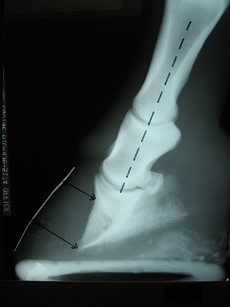
Scout Radiographs (X-Rays)
At both the AAEP and Laminitis conferences, it is highly recommended to have a lateral view with a lead marker on the hoof wall to allow precise (to the millimeter) measurements and to see if there is rotation. These films also assist your Farrier regarding toe length, shoe placement, and progress of improvement.
Farriers Discover New Laminitis Pathway
The link between IR (insulin resistance) and COPD (Bad Breathing). They churn each other – IR makes COPD worse, COPD makes IR worse and that leads to more laminitis.
![]() Click here to see 26 ways HEIRO is the Best Choice and why the winner over other products.
Click here to see 26 ways HEIRO is the Best Choice and why the winner over other products.
Proper diet and exercise is essential for horse health. This product is a supplement to help maintain horse health. This product is not intended to diagnose, treat, cure, or prevent disease.





; ?>/wp-content/themes/twentyten/img/NMImacLogo_150.jpg)
